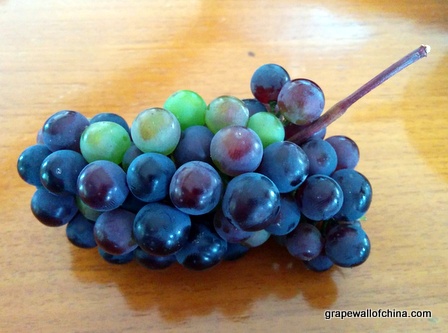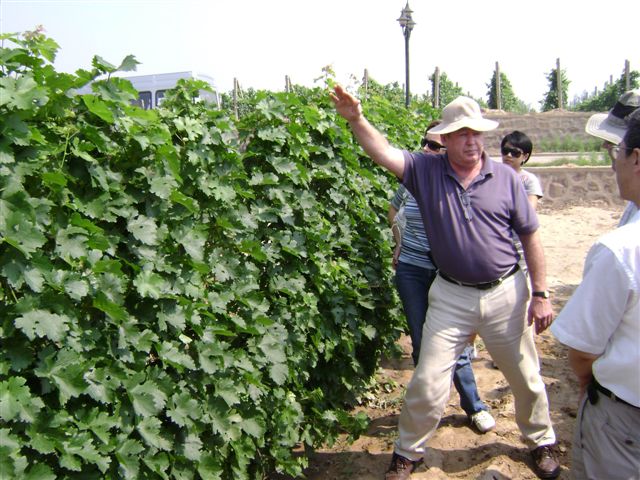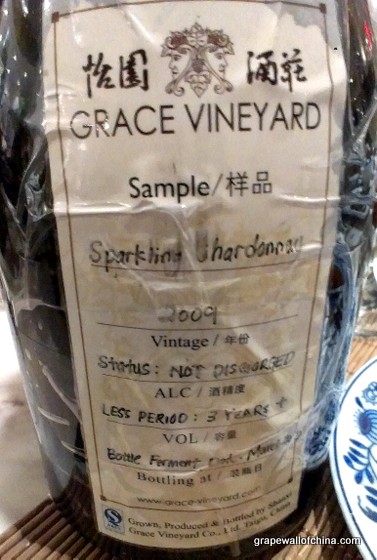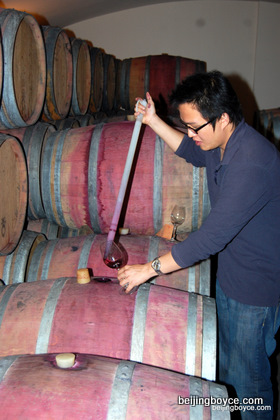
By Jim Boyce | The words “harvest report” might seem to portend bunches of figures and formulas and technical lingo but these records can lead to “a-ha!” moments. Such is the case with the 2010 report by now-retired winemaker Ken Murchison at Grace Vineyard in Shanxi province. I read it a few weeks ago while preparing for a Chinese wine tasting and it not only gave me extra perspective on Grace’s wines but also underscored why this winery arguably remains the most important in China.

Murchison first covers the weather, noting two major problems. First, early snow the previous fall prevented the burying of all of the vines—a process necessary to protect them from the long cold dry winters—and some froze to death. Second, the prolonged threat of frost the next spring prevented uncovering those vines the team managed to bury and that meant to a shorter growing season. Not the most auspicious of starts! Then came a trio of a-ha moments.
“After several years of successful trials with Ningxia grapes, we took the opportunity to “go-ahead†with a quantity of grapes from this province this year.”
“Our vineyard team spent much time travelling the Ningxia vineyards, carefully selecting quantities and varieties. The grapes had to meet the stringent quality requirements of Grace Vineyard. These wines will provide us with an interesting insight into the capabilities of our own vineyard in that province.”
Ningxia is firmly on the wine world’s radar now, and has hosted plenty of top writers, viticulturalists and consultants, but it was a fairly faint blip nearly six years ago when Grace sourced those grapes. The move showed Grace was not content with its success, which was achieved in near isolation in Shanxi, but realized the need to go forth and continually improve. Grace now regularly uses fruit from its own Ningxia vineyards.
… harvest began with a small quantity of Chardonnay grapes destined for our sparkling wine project. This was followed by our conventional Chardonnay harvest – this year producing fresh, crisp grapes and wines with good flavour and refreshing firmness.
When it comes to local sparkling wine, much of the talk over the past two years has focused on Moet-Hennessey’s Chandon project in Ningxia, which released its first commercial bubbly in 2015. Yet here was Grace in action years before the Chandon facility was even started. To be fair, there was more excitement in the 2009 report, the first year Grace turned its attention to sparkling wine, but it nevertheless shows how far back the project goes.


Last year, Grace released its first four sparkling wines, including entry-level Chenin Blanc, Chardonnay and Cabernet Franc and a Reserve Chardonnay made using the Champagne method. That reserve stayed on lees for more than five years after that 2009 harvest.
Red grapes followed in their usual sequence–Merlot, Cabernet Franc and Cabernet Sauvignon, although we did pick our first small quantity of an Italian varietal, Aglianico. Our opinions changed from day to day about this wine but the consensus is that it will be a soft savoury style with interesting cherry and raspberry characters.
As noted on this blog many times, China producers have long been obsessed with Bordeaux varieties, particularly Cabernet Sauvignon. A big issue for countries such as Spain and Italy, if they hope to catch France as a source of imported wine, is more consumer familiarity with the grapes from those countries. Here, in 2010, was a rare case of a red wine being made with grape variety closely associated with Italy. The first commercial Aglianico from Grace, as well as its first Shiraz and Marselan, were released last summer. (See here for a tasting.)

Overall, Murchison reported that he was “pleased” and that over 60 percent of the harvest would go to “reserve and above quality“. Given the initial weather challenges, the 2010 vintage turned out to be a success in general, but the more intriguing stories are the niche ones, those involving the Ningxia grapes or the sparkling wine or the Aglianico, as they show the sense of exploration that has allowed Grace to remain a leader in the China wine industry.
There has been plenty of debate about the quality of Grace’s wines as other operations, especially in Ningxia but also in Xinjiang, Shandong and elsewhere, have increasingly shone. But no one yet comes close to Grace in terms of overall importance.
Eighteen months ago, in the Grape Wall newsletter, I described Grace as the Yao Ming of China wine. (I recently re-posted that piece here.)  The point: when Yao Ming joined and then excelled in the NBA, many thought he would be the first in a long line of Chinese basketball stars. That didn’t happen.
The same goes for wine. When I first started drinking Grace wines a decade ago, I heard many people say other such wineries would soon catch up and then pass. It’s true, some small wineries, especially in Ningxia, have produced one or two or three wines for a few years that are good quality. And other wineries, usually massive ones, have produced dozens of wines for a long time that include many of dubious quality. But there is still no other operation that has not only produced a broad portfolio of decent wines for more than a decade, but also continually pushes the envelope and adds intriguing new products. The new head winemakers, Lee Yean Yean, has already shown a similar interest in experimentation and I expect we will find many more surprises in the harvest reports to come.

Check out the new online China Wine Directory. And get the free Grape Wall e-newsletter by signing up below.
Grape Wall has no sponsors of advertisers: if you find the content and projects like World Marselan Day worthwhile, please help cover the costs via PayPal, WeChat or Alipay.
Sign up for the free Grape Wall newsletter here. Follow Grape Wall on LinkedIn, Instagram, Facebook and Twitter. And contact Grape Wall via grapewallofchina (at) gmail.com.

Leave a Reply
You must be logged in to post a comment.